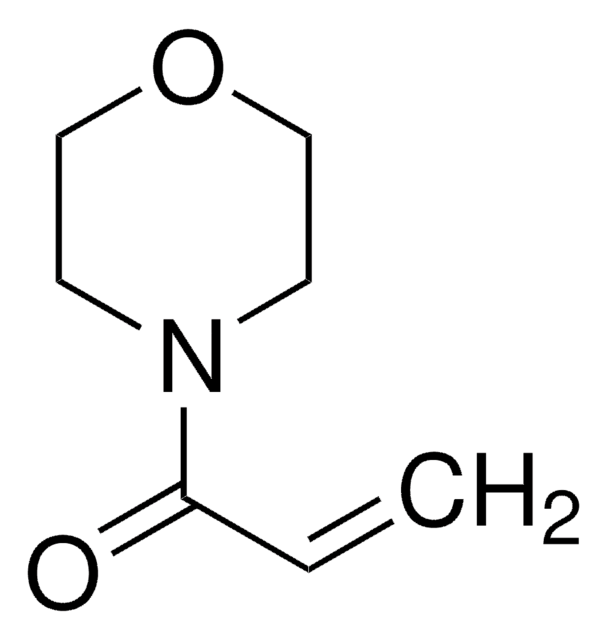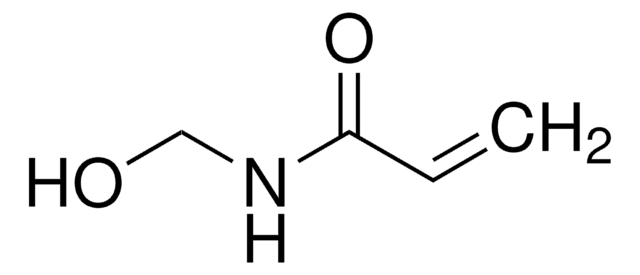If this product has an expiration or retest date, it will be shown on the Certificate of Analysis (COA, CofA). If there is no retest or expiration date listed on the product's COA, we do not have suitable stability data to determine a shelf life. For these products, the only date on the COA will be the release date; a retest, expiration, or use-by-date will not be displayed.
For all products, we recommend handling per defined conditions as printed in our product literature and website product descriptions. We recommend that products should be routinely inspected by customers to ensure they perform as expected.
For products without retest or expiration dates, our standard warranty of 1 year from the date of shipment is applicable.
For more information, please refer to the Product Dating Information document: https://www.sigmaaldrich.com/deepweb/assets/sigmaaldrich/marketing/global/documents/449/386/product-dating-information-mk.pdf
697931
N-Hydroxyethyl acrylamide
contains 1,000 ppm monomethyl ether hydroquinone as stabilizer, 97%
Synonyme(s) :
N-(2-Hydroxyethyl)acrylamide, HEAA
Sélectionner une taille de conditionnement
Sélectionner une taille de conditionnement
About This Item
Produits recommandés
Niveau de qualité
Essai
97%
Forme
liquid
Contient
1,000 ppm monomethyl ether hydroquinone as stabilizer
Indice de réfraction
n20/D 1.505
pb
129-130 °C
Densité
1.111 g/mL at 25 °C
Température de stockage
2-8°C
Chaîne SMILES
OCCNC(=O)C=C
InChI
1S/C5H9NO2/c1-2-5(8)6-3-4-7/h2,7H,1,3-4H2,(H,6,8)
Clé InChI
UUORTJUPDJJXST-UHFFFAOYSA-N
Catégories apparentées
Application
- preparation of hydrogels for the formation of a stimulo-responsive polymer for cell signaling and bioengineering research[1]
- in the synthesis of lanthanide based luminescent materials for sensors and bio-imaging[2]
- formation of adhesive hydrogel for potential usage in the smart adhesives[3]
Mention d'avertissement
Danger
Mentions de danger
Conseils de prudence
Classification des risques
Eye Dam. 1 - STOT RE 2 Oral
Code de la classe de stockage
10 - Combustible liquids
Classe de danger pour l'eau (WGK)
WGK 1
Point d'éclair (°F)
298.4 °F - closed cup
Point d'éclair (°C)
148 °C - closed cup
Équipement de protection individuelle
Eyeshields, Faceshields, Gloves, type ABEK (EN14387) respirator filter
Faites votre choix parmi les versions les plus récentes :
Déjà en possession de ce produit ?
Retrouvez la documentation relative aux produits que vous avez récemment achetés dans la Bibliothèque de documents.
Les clients ont également consulté
-
How can I determine the shelf life / expiration / retest date of this product?
1 answer-
Helpful?
-
-
How is shipping temperature determined? And how is it related to the product storage temperature?
1 answer-
Products may be shipped at a different temperature than the recommended long-term storage temperature. If the product quality is sensitive to short-term exposure to conditions other than the recommended long-term storage, it will be shipped on wet or dry-ice. If the product quality is NOT affected by short-term exposure to conditions other than the recommended long-term storage, it will be shipped at ambient temperature. As shipping routes are configured for minimum transit times, shipping at ambient temperature helps control shipping costs for our customers. For more information, please refer to the Storage and Transport Conditions document: https://www.sigmaaldrich.com/deepweb/assets/sigmaaldrich/marketing/global/documents/316/622/storage-transport-conditions-mk.pdf
Helpful?
-
-
N-ヒドロキシエチルアクリルアミドは水に溶解しますか?また、下限臨界溶液温度は何度くらいでしょうか?
1 answer-
Per the product's SDS, its water solubility is 1,000 g/l at 20 °C. However, details about its lower critical solution temperature are not tested or provided.
Helpful?
-
Active Filters
Notre équipe de scientifiques dispose d'une expérience dans tous les secteurs de la recherche, notamment en sciences de la vie, science des matériaux, synthèse chimique, chromatographie, analyse et dans de nombreux autres domaines..
Contacter notre Service technique






![N-[Tris(hydroxymethyl)methyl]acrylamide contains ≤7% KCl, 93%](/deepweb/assets/sigmaaldrich/product/structures/130/961/5bc6d1a4-a540-4496-9f46-74507af67e21/640/5bc6d1a4-a540-4496-9f46-74507af67e21.png)





